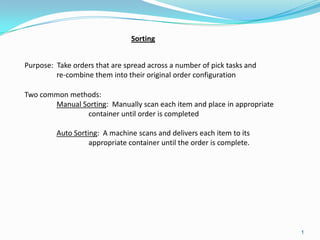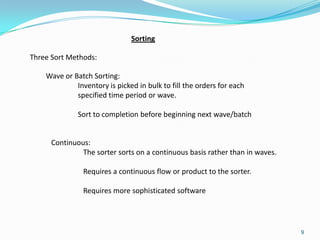Sorting
- 1. Sorting Purpose: Take orders that are spread across a number of pick tasks and re-combine them into their original order configuration Two common methods: Manual Sorting: Manually scan each item and place in appropriate container until order is completed Auto Sorting: A machine scans and delivers each item to its appropriate container until the order is complete. 1
- 2. Unitizing and Shipping Sorting 2
- 3. Sorting Types of Auto Sorting: Tilt Tray: Product placed on trays tilts to deliver product to desired chute. Bomb-Bay Cross-Belt: Instead of a tray that tilts, the “tray” incorporates a belt that delivers product to chutes either on the left or the right. Garment www.gbisorting.com 3
- 4. Sorting Different Auto Sorter Layouts and Designs Basic Inline Basic Oval Entertainment/Multi Media (v) Triple-Chute High Density Internet Order Fulfillment 4
- 5. Basic Inline 5
- 6. Basic Oval 6
- 8. Triple Chute High Density 8
- 9. Sorting Three Sort Methods: Wave or Batch Sorting: Inventory is picked in bulk to fill the orders for each specified time period or wave. Sort to completion before beginning next wave/batch Continuous: The sorter sorts on a continuous basis rather than in waves. Requires a continuous flow or product to the sorter. Requires more sophisticated software 9
- 10. Sorting Sort Methods: Multiple: Similar to wave/batch in that work is configured in waves or batches Able to sort multiple waves or batches at the same time Requires even more sophisticated software Uses a process called “dynamic chute allocation” 10
- 11. Sorting Options to use with automatic sorting: Print and Apply: The ability to print and apply unique labels to product while it is being sorted. Auto Induction (also called “metering and merging”) A belt feeds product onto the individual trays in a precise and accurate manner Leads to more consistent placement of product on trays for better accuracy and helps maximize throughput 11
- 12. Sorting Bomb Bay Different ways to deliver product to the chutes: Tilt Tray Cross Belt Split Tray 12
- 13. Shipping Sorter Scanner and conveyor system which sorts cases to their assigned shipping divert. Shipping Shipping looks deceptively simple. However, unless the shipping department accurately completes shipping documentation, correctly palletizes the loads, and places every pallet and carton on the correct trailer at the right time, all of the work accomplished within the warehouse, up to this point, is fruitless. Unitizing: The process of taking multiple items and creating one load, either by combining on a pallet, filling a carton, or filling a shipping container. Correctly executed, unitizing should eliminate split shipments 13
- 14. Shipping The appropriate application of unitizing is often overlooked as a way to reduce costs by ensuring we optimize the shipping container by using the correct size carton/container, the container is labeled correctly, and the containers are properly configured. “Containers” may include mobile secure cages, modular containers, plastic or wooden pallets, plastic totes, corrugate boxes, etc… Weight Checking is simply a process to verify that the actual weight of the order is equal to the expected weight, +/- a small percentage for corrugate and dunnage. End 14
- 15. Individual Presentations When: Wednesday April 27th Subject: 1. Illustrate how some of the topics we have discussed in class may be relevant to your current and/or previous work experience. 2. What are your three biggest takeaways from this class? 3. Based on what we covered in class, how has your view of distribution chain and warehousing changed? Length: 10-15 minutes You can use whatever method you like to present to the class: Overheads, PowerPoint, or handouts, etc… 15














